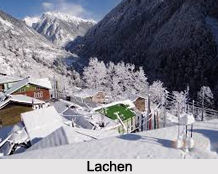 North Sikkim District is a district, where Mangan is the headquarter and it is the favourite zone for the adventure lovers and trekkers. Mangan is known as the Cardamom Capital of the world. The climate and terrain of Mangan best suits for the cultivation of the larger variety of Cardamom here. North Sikkim District is home to the red panda. This animal is the pride of Sikkim and is also the state animal. It is generally found between heights of 2000 meters to 4000 meters. It is as big as a domestic Siamese cat, has a triangular shaped face with a stripe on its cheek, with red fur and black eyes. It has a sprinkling of white on its back and chest. The tail is bushy, black or brown in colour and long like that of a skunk. They generally live on treetops.
North Sikkim District is a district, where Mangan is the headquarter and it is the favourite zone for the adventure lovers and trekkers. Mangan is known as the Cardamom Capital of the world. The climate and terrain of Mangan best suits for the cultivation of the larger variety of Cardamom here. North Sikkim District is home to the red panda. This animal is the pride of Sikkim and is also the state animal. It is generally found between heights of 2000 meters to 4000 meters. It is as big as a domestic Siamese cat, has a triangular shaped face with a stripe on its cheek, with red fur and black eyes. It has a sprinkling of white on its back and chest. The tail is bushy, black or brown in colour and long like that of a skunk. They generally live on treetops.
Geography of North Sikkim District
The landscape of North Sikkim District is a mountainous region with dense vegetation all the way up to the alpine altitude before thinning out to desert scrub towards the northern tundra. Numerous waterfalls astride the main road to make the trip to this district extremely picturesque.
Climate of North Sikkim District
The temperature of North Sikkim District ranges from about 25 degree Celsius to below 40 degree Celsius in the tremendous high reaches where the altitude is in excess of 6,000 metres. Mt. Kanchenjanga is the highest peak at over 8,000 m, straddling its western border with Nepal and can be seen clearly from the town of Singhik.
Landforms of North Sikkim District
The most prominent effect of the steepness of the valleys is the prevalence of landslides that at times drop to anything between 3000 to 5,000 ft (1,500 m) carrying devastation along their course. Most of them are caused either by the melting snow beds on top of the mountains or by erosive action of the rains.
Administrative Headquarter of North Sikkim District
Most of the people of North Sikkim District reside near Mangan, the district headquarters which is about 2,000 feet (610 m) above sea level. It is also the center of administration. Further north the elevation increases with the vegetation turning from temperate to alpine to tundra.
Demography of North Sikkim District
According to the Population census in the year 2011, North Sikkim district has a population of 43,354. North Sikkim District has a population density of 10 inhabitants per square kilometers. Its population growth rate over the decade 2001-2011 was 5.66%. North Sikkim has a sex ratio of 769 females for every 1000 males, and a literacy rate of 77.39%.
Culture of North Sikkim District
The people of North Sikkim District are mainly of Lepchas and Bhutia descent. Other groups include the Tibetan community. It also has one of the lowest populated regions of the state.
Economy of North Sikkim District
The economy of North Sikkim District is depending on hydel power and the cardamom production. North Sikkim District has many power projects and enjoys almost uninterrupted electricity. The steep gradient and the innumerable lakes on the higher reaches facilitate ideal conditions for generation of hydroelectric power. In 2006, the Ministry of Panchayati Raj named North Sikkim District as one of the country`s 250 most backward districts (out of 640). It is the only district in Sikkim currently receiving funds from the Backward Regions Grant Fund Programme (BRGF).
Tourism in North Sikkim District
Most of North Sikkim District is restricted to travelers and permits are needed to visit these areas. The area, which shares a sensitive border with the People`s Republic of China is heavily patrolled by the Indian Army. However, in view of exquisite scenic beauty, a large number of tourists have started visiting the region overcoming all sorts of hardship. Often unregulated tourism becomes a major conservation issue in fragile ecosystem such as high mountains.






